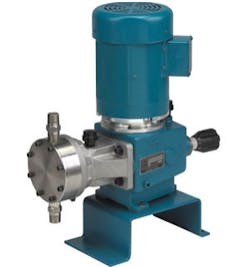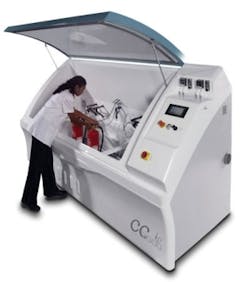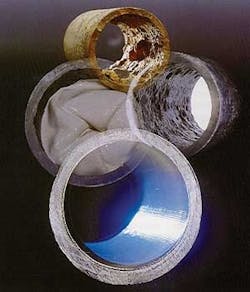By Tom O'Donnell
Metering pumps are used in a variety of municipal drinking water and wastewater applications to dispense treatment chemicals for disinfection, filtration, clarification, coagulation, flocculation, etc. Metering pumps meet these requirements because they have the flexibility to easily vary the amount of chemical dosage rates, according to the process conditions. They are also ideal in handling a wide variety of corrosive or viscous liquids, as well as acids, bases and solvents.
Taking all of these parameters into account, metering pumps rightfully remain one of the most versatile and relied-upon technologies for the safe, accurate and efficient injection of a unique array of chemicals in municipal water applications. The goal of this article is to help the user define the variables that need to be evaluated when choosing and installing the proper metering pump or complete chemical-feed system. Selecting the proper pump and feed system will not only help inject liquids or slurries regardless of viscosity, but also ensure that it is done in the most efficient and energy-wise manner.
Sizing
As seems to be the case with most everything, size really does matter when determining the proper metering pump to be used in a water treatment application. More specifically, the size in terms of capacity of both the pump's flow rate and discharge pressure. Simply put, metering pumps should not be oversized. In fact, a metering pump should be sized so that its maximum expected flow rate is 85% to 90% of the pump's capacity, which leaves additional capacity, if needed. At the other end of the spectrum, a metering pump's minimum capacity should never be less than 10% of the capacity; anything less will in many cases affect the pump's accuracy.
Metering pumps are selected based on the proper flow rates, discharge pressures and type of fluids to be pumped in the specific application. Once that is determined, the type of metering pump can be selected, i.e. hydraulic diaphragm, mechanically actuated diaphragm, solenoid driven or piston style.
Hydraulic Diaphragm Pump
Materials of Construction
Another key determination is materials of construction. Selection of a metering pump must take into consideration any corrosion, erosion or solvent action that may occur when handling specific substances. For example, solvents may dissolve pump heads constructed of plastic, acids and caustics may only be compatible with stainless steel or certain steel alloys, and abrasive slurries can erode some materials.
Therefore, the best lines of metering pumps will be available in a range of materials of construction, allowing the end-user to choose the appropriate option for his specific application.
Drivers
Selecting a driver is also an area of concern. A driver should be chosen by matching it to the available utilities, which usually include electric, air, gas or other means of driving the pump. When the pump's parameters are determined, you must then consider the environment in which the pump will operate. Hazardous-area requirements must also be identified when selecting the driver.
When evaluating a hazardous environment, remember to consider dust, which can ignite, just like fumes or vapors. Is the pump to be used indoors or outdoors? If it's located outdoors, it should be sheltered from direct sunlight. As far as temperature requirements, most pumps will operate in freezing conditions provided that the fluid to be pumped will not freeze and that the correct lubricants are selected. In this case, freeze protection and heat-tracing may be required, while operation in corrosive environments may require special pump coatings.
Control Systems
Determining the pump's method of control is next on the list of determining factors. The choices usually include manual continuous operation, on/off operation or automatic proportional control in response to a process signal.
In general, metering pump flow rates can be manually adjusted through the use of a micrometer dial. This manual control allows the pump to be operated between 10% and 100% of capacity by changing the stroke length. By comparison, a manual variable-speed drive changes the stroke speed. A combination of the two may allow additional adjustability or turndown over the range of the drive, depending upon the stroking speed of the pump. For example, a pump operating at 75 strokes per minute (which could be turned down to 15 spm) would allow a 5:1 turndown on speed when using the variable-speed drive and a 10:1 turndown on stroke length when using the micrometer dial.
Metering pump flow rates can also be controlled automatically (in response to a process signal) by electric positioners that change the pump's stroke length, or by variable speed drives that alter the stroking speed. Using a positioner gives the operator a full 10:1 turndown, which is the full adjustable range. Using a variable speed drive will supply only as much turndown as the ratio of the pump stroking speed divided by the minimum operating speed of the pump.
Be reminded that it is not practical to use a variable speed drive on motor-driven pumps that normally operate at less than 100 spm. Slowing the motor causes each stroke to take longer from start to finish and, as a practical matter, hydraulic motor-driven pumps should not be operated at less than 15 spm. Electronic diaphragm pumps, which are pulsed by a solenoid, can operate at less than a single stroke per minute because the characteristic and timing of each stroke, from start to finish, is the same at all stroking speeds. The highest stroking speeds should be avoided with viscous or abrasive chemicals.
When a metering pump is controlled by automatic or electric stroke positioners, the number of doses remains constant and the size of each dose is reduced, thus keeping the doses uniformly distributed in a constantly flowing line. Use of a variable-speed drive changes the stroke speed, while the size of the dose injected on each stroke remains the same, but makes the doses less frequent as the motor speed is slowed. This, however, can produce an undesirable process result in a constantly flowing line as the discreet slugs of chemical are more widely separated than if a constant dose interval were maintained.
Conclusion
Finally, consider the application and level of quality. Is the unit to be used for intermittent operation in an HVAC or light-duty applications where economy is an important consideration? Is the unit for a municipal waste treatment facility where ruggedness and additional features are required? Is initial cost or life-cycle cost more important?
In municipal water treatment applications, metering-pumping technology should be selected that offers the best in operation, reliability and energy efficiency when handling a wide array of liquids, chemicals and slurries. In a time when municipal utilities are striving to optimize processes and improve efficiencies, having the best chemical-metering pumps on hand makes meeting those goals much easier and safer. WW
About the Author:Tom O'Donnell is Senior Product Specialist for Lansdale, PA-based Neptune Chemical Pump Co., an operating company with the Pump Solutions Group (PSG™). O'Donnell can be reached at [email protected]Planning a Metering Pump Installation
"We intend to complete a new water treatment plant with the capability to produce 6M gallons per day. Our area continues to grow therefore we will be A metering-pump installation must be planned from the day tank or liquid source up to the injection point. Remember that hydraulic metering pumps will "push" against great pressures but they will not "pull" for great distances. Since it is easier to prime and more forgiving, a flooded suction is always preferred, and must be used for fluids where vapor pressure might be less than the suction lift.
Be careful to limit the suction to four feet in a suction-lift application, and a foot valve must be used in a top-mount application. Limit the length of a flooded suction to six or seven feet and use an adequately sized line with minimized bends, elbows or other restrictions. When considering the piping, the safest rule-of-thumb for selecting suction pipe size is to use one size larger than the pump suction connection. For discharge piping, specify piping that is suitable for the discharge pressure.
Other accessories to be considered when planning a metering pump installation include:
• Suction strainer • Flanges, unions or compression fittings • Isolation valves • Calibration column • Relief valve • Back pressure valve • Pressure gauge • Pulsation dampener • Injection quill and check valve
Finally, remember that when replacing equipment or changing chemical programs, it is best to ask questions. Will the new program operate at the same feed rates as the previous one? Is the equipment properly sized for the new products? How well has the equipment been operating? Any problems with reliability, accuracy or unusually high maintenance requirements?
There is no better start to a new chemical feed program than to ensure that the chemical is delivered accurately with trouble-free equipment.
More WaterWorld Current Issue Articles
More WaterWorld Archives Issue Articles





